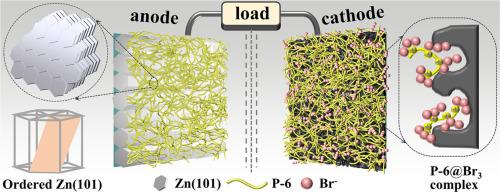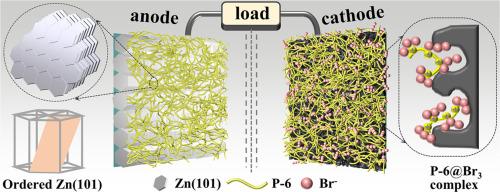双功能阳离子聚电解质添加剂实现无枝晶和抑制穿梭的锌-溴电池
IF 20.2
1区 材料科学
Q1 CHEMISTRY, PHYSICAL
引用次数: 0
摘要
锌-溴(Zn-Br2)电池由于其低成本和高能量密度而成为大规模储能的有吸引力的候选者。然而,它们的实际部署仍然受到锌枝晶生长和多溴离子穿梭扩散效应的阻碍,这损害了长期循环和能源效率。在此,我们介绍了一种低浓度,双功能聚电解质添加剂,聚季铵盐-6 (P-6),同时解决了这两个挑战。电化学分析、原位拉曼光谱和理论计算表明,P-6选择性地吸附在Zn(002)/(100)表面,促进Zn沿动力学有利的(101)取向均匀沉积,同时通过静电屏蔽抑制枝晶的形成。同时,P-6与Br3-和Br5-形成稳定的配合物,有效抑制其穿梭扩散。因此,仅含0.65 wt. % P-6 (~ 44 mM)的Zn-Br2电池可提供约1300 μAh cm-2的高容量,并在1500次循环中表现出出色的稳定性,库仑效率为98%。这种双功能电解质策略有效地解决了锌- br2电池中的界面挑战,并可作为更广泛的卤素基水溶液体系添加剂设计的指导原则。本文章由计算机程序翻译,如有差异,请以英文原文为准。


Bifunctional cationic polyelectrolyte additive enables dendrite-free and shuttle-suppressed zinc-bromine batteries
Zinc-bromine (Zn-Br2) batteries are attractive candidates for large-scale energy storage owing to their low cost and high energy density. However, their practical deployment remains impeded by the zinc dendrites growth and polybromide shuttle diffusion effects, which compromise long-term cycling and energy efficiency. Herein, we introduce a low-concentration, bifunctional polyelectrolyte additive, polyquaternium-6 (P-6), that simultaneously addresses both challenges. Electrochemical analyses, in-situ Raman spectroscopy, and theoretical computation reveal that P-6 selectively adsorbs on Zn (002)/(100) facets, facilitating uniform Zn deposition along the kinetically favourable (101) orientation while suppressing dendrite formation via electrostatic shielding. Simultaneously, P-6 forms stable complexes with Br3- and Br5-, effectively inhibiting their shuttle diffusion. Consequently, Zn-Br2 battery incorporating only 0.65 wt. % P-6 (∼44 mM) delivers a high capacity of ∼1300 μAh cm-2 and exhibit outstanding stability over 1500 cycles with >98 % Coulombic efficiency. This bifunctional electrolyte strategy effectively addresses interfacial challenge in Zn-Br2 batteries and may serve as a guiding principle for the design of additives in broader aqueous halogen-based system.
求助全文
通过发布文献求助,成功后即可免费获取论文全文。
去求助
来源期刊

Energy Storage Materials
Materials Science-General Materials Science
CiteScore
33.00
自引率
5.90%
发文量
652
审稿时长
27 days
期刊介绍:
Energy Storage Materials is a global interdisciplinary journal dedicated to sharing scientific and technological advancements in materials and devices for advanced energy storage and related energy conversion, such as in metal-O2 batteries. The journal features comprehensive research articles, including full papers and short communications, as well as authoritative feature articles and reviews by leading experts in the field.
Energy Storage Materials covers a wide range of topics, including the synthesis, fabrication, structure, properties, performance, and technological applications of energy storage materials. Additionally, the journal explores strategies, policies, and developments in the field of energy storage materials and devices for sustainable energy.
Published papers are selected based on their scientific and technological significance, their ability to provide valuable new knowledge, and their relevance to the international research community.
 求助内容:
求助内容: 应助结果提醒方式:
应助结果提醒方式:


